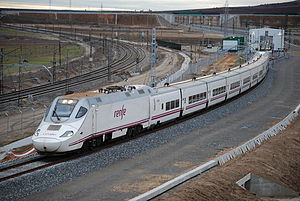Talgo 250
| RENFE Class 130 Talgo 250 |
|
|---|---|
 |
|
| Manufacturer | Talgo / Bombardier (Kassel) |
| Number built | 45 |
| Capacity | 11 coach set: 299 seats, 236 standard, 62 first, 1 special |
| Operator(s) | RENFE |
| Specifications | |
| Train length | 183 m (600 ft 4.7 in) |
| Car length | 20 m (65 ft 7.4 in) (power car) 13.14 m (43 ft 1.3 in) (passenger car) |
| Width | 2.96 m (9 ft 8.54 in) (power car) |
| Height | 4 m (13 ft 1.48 in) (power car) |
| Maximum speed | 250 km/h (160 mph) (standard gauge lines) 220 km/h (140 mph) (Iberian gauge lines) 180 km/h (110 mph) (S730; diesel mode) |
| Weight | (?) |
| Axle load | max. axle load 18 t (17.7 long tons; 19.8 short tons) |
| Traction system | Electric |
| Prime mover(s) | 2x MTU 12V 4000 R43L (S730) |
| Power output | 2,400 kW (3,200 hp) @ 25 kV AC 2,000 kW (2,700 hp) @ 3 kV DC (per power unit) 1.8 MW (2,400 hp) per power car in diesel mode (S730) |
| Electric system(s) | 25 kV 50 Hz AC / 3 kV DCCatenary |
| Current collection method |
Pantograph (2 per power car) high voltage roof mounted electrical bus between power cars. |
| UIC classification | Bo'Bo' 1,1,1,1,1,1,1,1,1,1,1,1 Bo'Bo' (11 car set) |
| Bogies | BoBo (power car) Articulated independent wheel 'single axle' in passenger cars |
| Braking system(s) | 2 disc brakes per axle regenerative and rheostatic brakes in power cars pneumatic discs in passenger cars |
| Track gauge | 1,435 mm (4 ft 8 1⁄2 in) / 1,668 mm (5 ft 5 21⁄32 in) |
The RENFE Class 130 or S-130 (Spanish: Serie 130 de Renfe, manufacturer's designation Talgo 250) is a high-speed dual-gauge, dual-voltage trainset consisting of 11 Talgo VII tilting coaches and two power cars, used on Alvia services. The class have been nicknamed patitos (ducklings), due to the shape of the train nose.
The trainsets are designed for high-speed services on Iberian gauge (1,668 mm (5 ft 5 21⁄32 in)) and high-speed (1,435 mm (4 ft 8 1⁄2 in)) lines; they can change gauge at low speed without stopping using Talgo's RD variable gauge system. The carriages are constructed from aluminium and incorporate the Talgo Pendular passive pendulum tilting system, are sealed against pressure differences for tunnel travel, and have underframe air conditioning, individual audio systems and video displays, rotating and reclining seats and power outlets.
Capacity in standard class is 36 seated, in first class 26 seats, end coaches have lower capacity, one coach is typically used for restaurant/sales services.
The locomotives use AC traction motors controlled by IGBT inverters which include integrated auxiliary inverters. Signalling systems can include ETCS Level 2, LZB, ASFA and Ebicab900TBS.
As of January 2010 they operated from Gijon/Oviedo via León, Palencia, Valladolid to Madrid with some trains extended to Alicante via Albacete;Santander via Palencia and Valladolid to Madrid, sometimes extended to Alicante; Madrid to Bilbao via Valladolid and Burgos; Madrid to San Sebastian/Irun via Valladolid, Burgos and Vitoria; and Madrid to Alicante;Huelva and Cadiz.
...
Wikipedia
